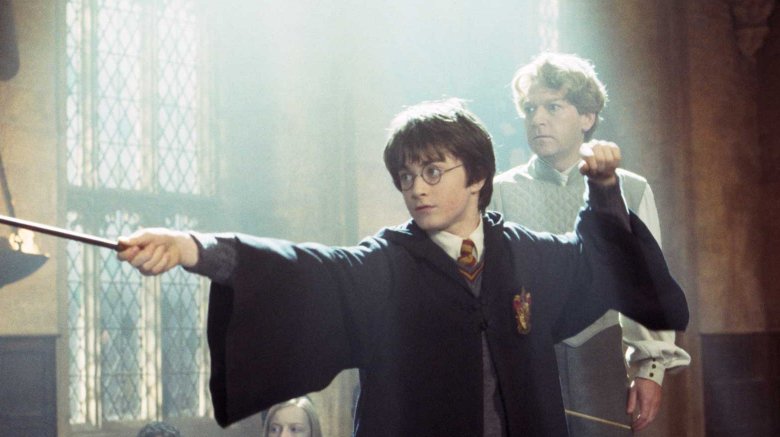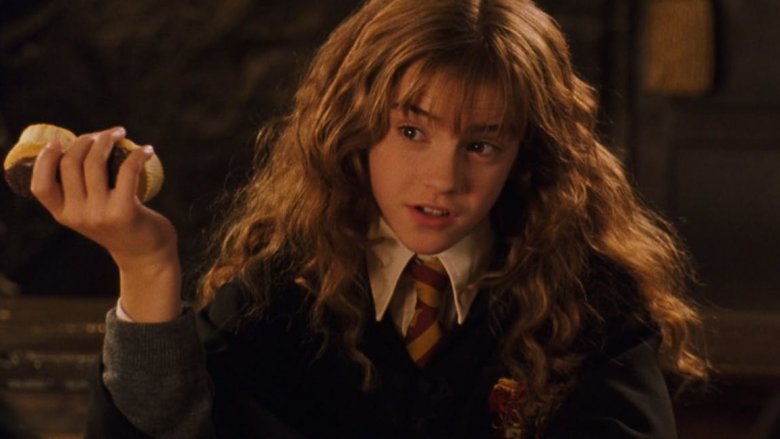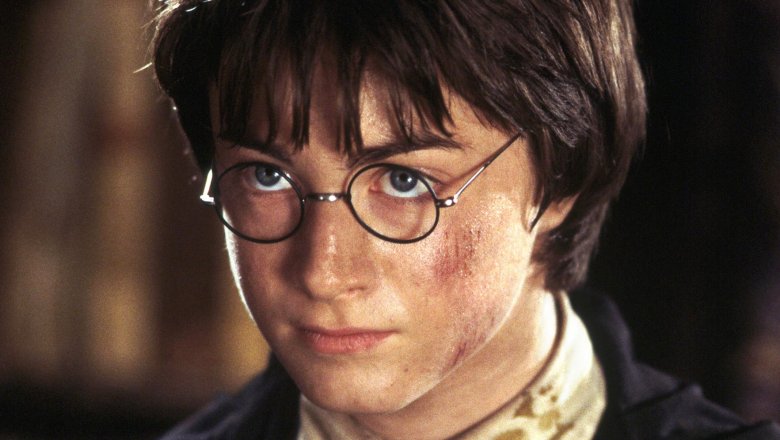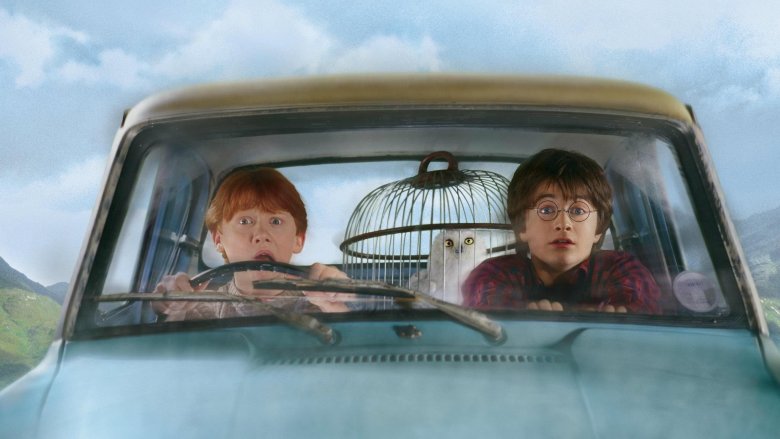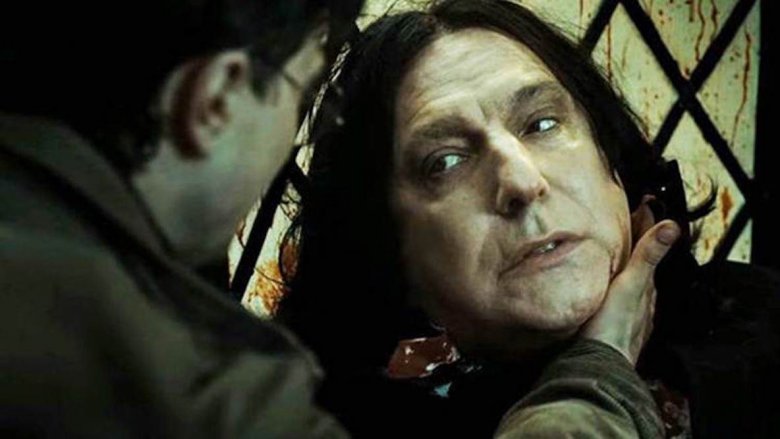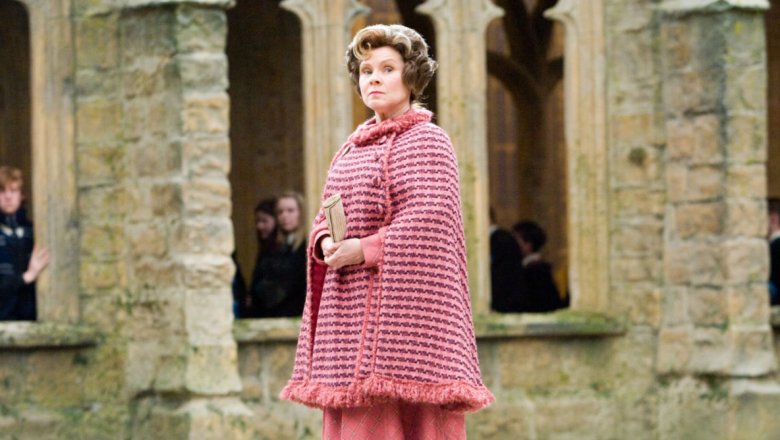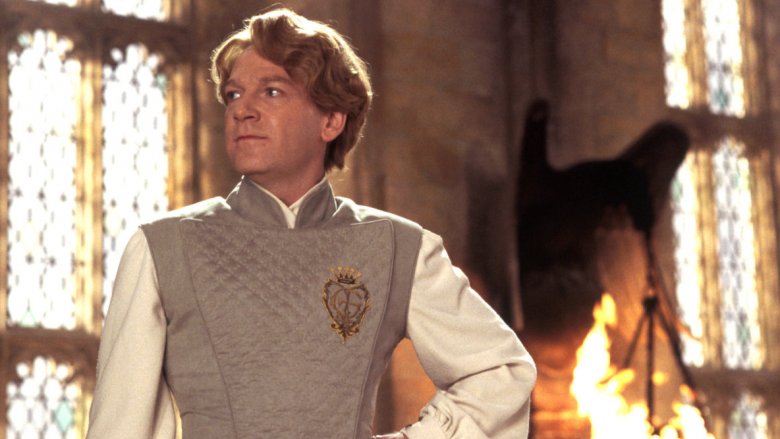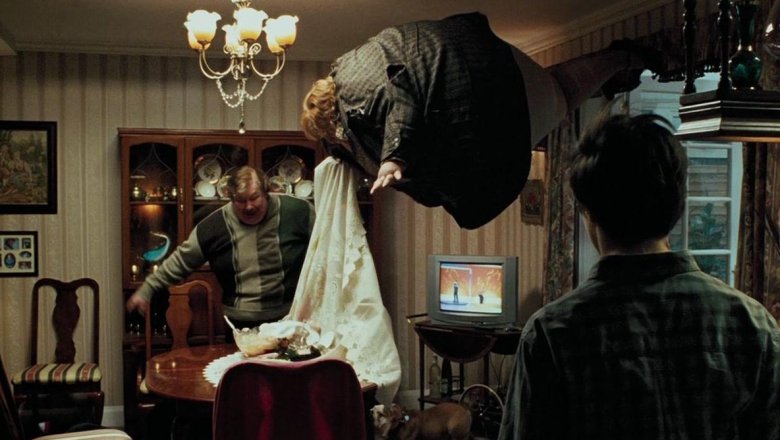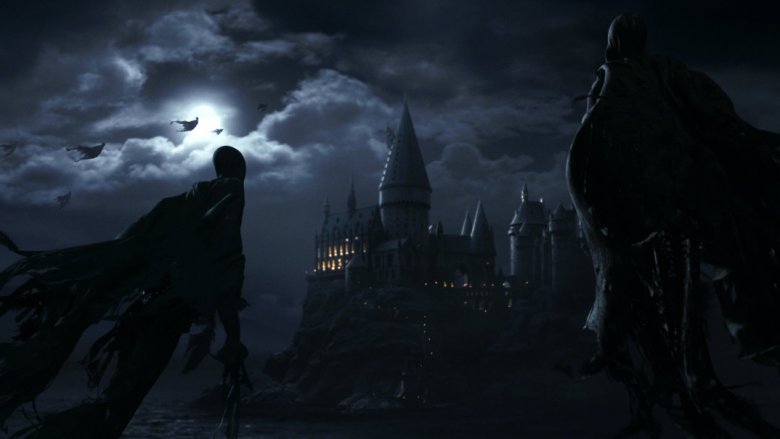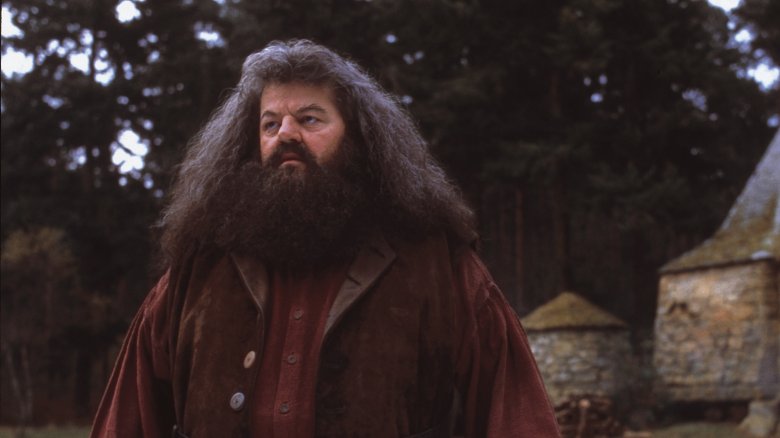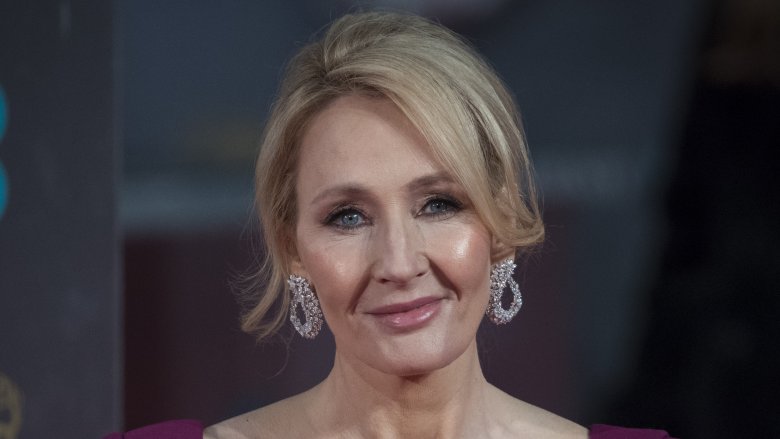The Real People Who Inspired These Harry Potter Characters
J.K. Rowling's world of witchcraft and wizardry isn't without its real-life influences. Although the characters in her Harry Potter series are all fictional — with the exception of a few errant folks like Fantastic Beasts: The Crimes of Grindelwald's Nicolas Flamel, of course — the author did draw upon a few key traits from some real-world personas to create some of those fan favorites.
We're not just talking about all of those fancy references to famous historical figures and the little linguistic tricks contained in her names and places, either. In some cases, there are or were actual modern-day Muggles who made enough of an impression on Rowling's life to inspire her to scrawl them onto the pages of her epic fantasy series. You might be surprised at just how many of your favorite magical figures have a real-life counterpart walking around with some major bragging rights (or, in a few cases, shame) about lending their traits to some of the most popular Harry Potter characters on the page and screen.
Hermione Granger is somewhat autobiographical
Let's start with one that might be a little more obvious than the rest: J.K. Rowling definitely put some of herself into at least one of her characters. While fans might be tempted to point to the relentless gossip columnist Rita Skeeter as Jo's literary doppelganger — since, you know, she's also a writer documenting all things wizarding — it is actually the so-called cleverest witch of the series who more closely resembles her creator.
Rowling admitted in a 1999 interview that the character was "loosely based" on herself at a younger age. "She's a caricature of me when I was 11, which I'm not particularly proud of," Rowling said. "She's quite annoying in a lot of ways. [...] I consciously try to make it clear that underneath the aggravating surface is someone who is actually quite insecure, hence her constant struggle to be the best." Rowling also said that she modeled the character's growth after her own shedding of certain adolescent grievances, promising at the time, "Hermione will loosen up a lot. In fact, she does loosen up a lot in Chamber of Secrets — as I did as I got older." No word yet on whether Rowling's eventual change of heart about Hermione's romantic choices also has any bearing on her real life, but if they do... well, yikes.
Harry Potter is based on a neighbor boy
No, there wasn't some kid with a lightning bolt on his forehead living beneath the stairs, but there were a couple of pint-sized Potters Rowling knew who played a part in developing some of Harry's attributes. Rowling remembered playing dress-up as witches and wizards with some neighborhood kids when she was growing up in Yate. She told The Guardian, "A gang of children, including myself and my sister, used to play together up and down our street. Two of the gang members were a brother and sister whose surname was Potter. I always liked that name."
It was about more than just a name, though. According to The Telegraph, Ian Potter in particular was something of a prankster and had an obsession with slugs, which might ring familiar to fans of Fred and George Weasley, or anyone who remembers when Ron's slug-slinging spell backfired. "Ian was the perfect inspiration for a wizard. He was a nightmare, forever playing tricks," his sister Vikki told The Guardian. "He used to do things like booby-trapping the stabilizers on my bike, and collecting tadpoles in jars and then plastering the green slime everywhere."
Harry might not have been into gross trickery like Fred and George were, but he sure wasn't afraid to get himself into some sticky situations either. This Ian Potter sounds like the perfect recruit for Gryffindor — his brashness might've subconsciously inspired the whole house for all we know.
The real Ron Weasley was Rowling's childhood bestie
Harry's own right hand man, Ron Weasley, was inspired by kid named Sean Harris, who often helped young Rowling escape the malaise of adolescence. As Rowling would later admit to Wales Online, Harris' car was what allowed the then-teen to fly away on her own adventures. "That turquoise and white car meant freedom and no more having to ask my father to give me lifts, which is the worst thing about living in the countryside when you are a teenager," she remembered. "Some of the happiest memories of my teenage years are zooming off into the darkness in Sean's car."
That old car would, of course, find its way into the opening scene of Harry Potter and the Chamber of Secrets, when Ron springs Harry from his aunt and uncle's house, as Rowling has admitted. "Harry was rescued by that car, just as the car rescued me from my boredom," Rowling explained. This Harris chap was supportive of her authorial ambitions and even gave her a loan in an hour of need, so getting to serve as inspiration for the reliable BFF with a heart of gold is the least she could do, really.
A science teacher informed Severus Snape
Early on in the series, the news that potions professor Severus Snape was inspired by a real-life person might sound like an insult to said individual, but once the tough-talking teacher turned out to be one of the good guys, that all changed. John Nettleship is the science teacher whose visage was borrowed for the development of Snape, and he said he's proud to have inspired the author. He told Wales Online, "I guess I was rather like the Professor Snape character in the books — demanding, wouldn't suffer fools gladly, exacting. I don't know if she was actually scared of me. She was a somewhat timorous child, but what she especially detested was chemistry. I don't know how much of it was the subject or the teacher."
Nettleship didn't realize that he was the source of inspiration for the character, though, until his own wife told him as much. "I asked my wife, Shirley, if she thought I was Professor Snape and she said, 'Of course you are. But I didn't like to tell you because I knew you wouldn't like it,'" he recalled. "She'd been laughing that this crotchety old bugger in these books was the man she was married to." Nettleship passed in 2013, but hopefully he got to at least read the final installment to see how his literary doppelganger redeemed himself in the end.
Dolores Umbridge was based on a real teacher, too
Snape might've gotten enough redemption in the stories to appease his namesake, but a teacher immortalized as the basis for Dolores Umbridge would presumably be a lot less happy about it. Rowling explained in a post for Pottermore that there was a teacher she "disliked intensely on sight" and who apparently returned her disfavor. "Why we took against each other so instantly, heartily and (on my side, at least) irrationally, I honestly cannot say. What sticks in my mind is her pronounced taste for twee accessories."
While she did clarify that there were some significant differences between the real-life woman she loathed and the vitriolic Order of the Phoenix villain — "she did not look like a toad, she was never sadistic or vicious to me or anyone else, and I never heard her express a single view in common with Umbridge," Rowling wrote — she admitted that her feud and this teacher's taste for peculiar and saccharine fashion accessories was well-remembered when she wrote about Professor Umbridge. "I particularly recall a tiny little plastic bow slide, pale lemon in color that she wore in her short curly hair."
Gilderoy Lockhart comes from an unnamed nemesis
The boastful and phony Professor Gilderoy Lockhart couldn't actually fight his way out of a paper bag, but to hear him tell tale, he was the greatest and most accomplished wizard that ever lived. While J.K. Rowling hasn't named any names, she has admitted that there was someone she once knew who embodied that same kind of resplendent fakery.
In a 2004 chat at the Edinburgh Book Festival, she explained, "I have to say that the living model was worse. He was a shocker! The lies that he told about adventures that he'd had, things he'd done and impressive acts that he had committed... He was a shocking man. I can say this quite freely because he will never in a million years dream that he is Gilderoy Lockhart." Rowling added that she was afraid whoever it was might eventually figure it out and confront her, but she's still willing to admit the representation was deliberate, saying, "the only character who I sat down and thought that I would base on someone is Gilderoy Lockhart. It made up for having to endure him for two solid years." Forget finally identifying "Becky with the Good Hair," we want to know who this mystery person is.
Aunt Marge borrowed from her grandmother
Remember Aunt Marge, Uncle Vernon's sister who insults Harry and his late parents until he loses control of his magic magic and blows her up bigger than Violet Beauregarde in Charlie and the Chocolate Factory? She, too, takes particular inspiration from Rowling's life: her grandmother Frieda. Frieda Volant is described as having preferred "her dogs to human relatives," much the way Aunt Marge seems to in her brief but memorable scenes in Harry Potter and the Prisoner of Azkaban.
Although Rowling would later wish she could walk back one thing about her depiction of Marge — "I regret making Aunt Marge a breeder of bulldogs, as I now know them to be a non-aggressive breed," she wrote on Pottermore — she has kept her thoughts about the real-life woman who inspired such an unpleasant guest star of the Harry Potter universe closer to the chest. It's worth noting, though, that both of Rowling's grandfathers got a merrier homage in the characters of Stanley and Ernest during the Knight Bus scenes.
The dementors are drawn from her own past
Before she became the author of an international phenomenon, J.K. Rowling had more than her share of struggles. As she has recalled many times, including in her address to Harvard University graduates in 2008, she wrote the series from what she described to be "rock bottom," a point in her life when she was a poor single mother with few prospects for success. Writing about the Boy Wizard's travails was her avenue of release.
She suffered through a deep depression during those times, and that experience with facing her own demons would later manifest in the dementors which were used to imprison exiles in the Harry Potter series. In a 2000 interview with The Times UK, she admitted, "It was entirely conscious. And entirely from my own experience. Depression is the most unpleasant thing I have ever experienced. It is that absence of being able to envisage that you will ever be cheerful again. The absence of hope. That very deadened feeling, which is so very different from feeling sad. Sad hurts but it's a healthy feeling. It's a necessary thing to feel. Depression is very different." Similarly, the dementors simply suck all hope out of their subjects and create an eternal trap from which there is no escape.
Hagrid was inspired by one of the Hell's Angels
J.K. Rowling wasn't the only one to draw Harry Potter inspiration from the people around her. To portray Rubeus Hagrid in the film adaptations, actor Robbie Coltrane decided that his gentle giant alter ego could stand to look a little tougher.
In an interview with the Daily Record, Coltrane admitted that he once met a member of the Hells Angels motorcycle gang and drew some cues from him in developing his approach to the role. "He used to get off of his Harley and walk towards the bar. People would move like ants out of his way. He would grab his pint, find a seat and say: 'I don't know about you, but the petunias this year are very bad,'" the actor remembered. "He was a gardener but he had fists like hams. He had a gentle heart. When we started talking about it, J.K. and I talked for three hours. She told me all about Hagrid's past, so I felt very confident about the part." Certainly, that accidental intimidation factor came through in Coltrane's portrayal — as did his aptitude for riding that hog.
Natalie McDonald was a real girl who made it onto the page
Last but certainly not least, little Natalie McDonald deserves a mention here, too. In the text of Harry Potter and the Goblet of Fire, there's a throwaway line about how Nearly Headless Nick was delighted to hear that House Gryffindor's newest recruit was one "McDonald, Natalie," and while that might not seem significant on its own, the backstory of this namedrop is very meaningful.
At the time of the writing, Rowling's literary reps were approached by the family of a nine-year-old girl battling leukemia who was obsessed with the Harry Potter series, and Rowling responded to the girl with a very personal note. "Jo's email was beautiful," the girl's family friend would later remember. "She didn't patronize Natalie, or tell her everything was okay; she addressed her as a human being who was going through a hard time. She talked about her books and her characters and which ones she liked best." Sadly, little Natalie didn't live long enough to read it herself, and Rowling would later include McDonald's name in her book as a bit of honor to the late little girl who loved her stories so well.
